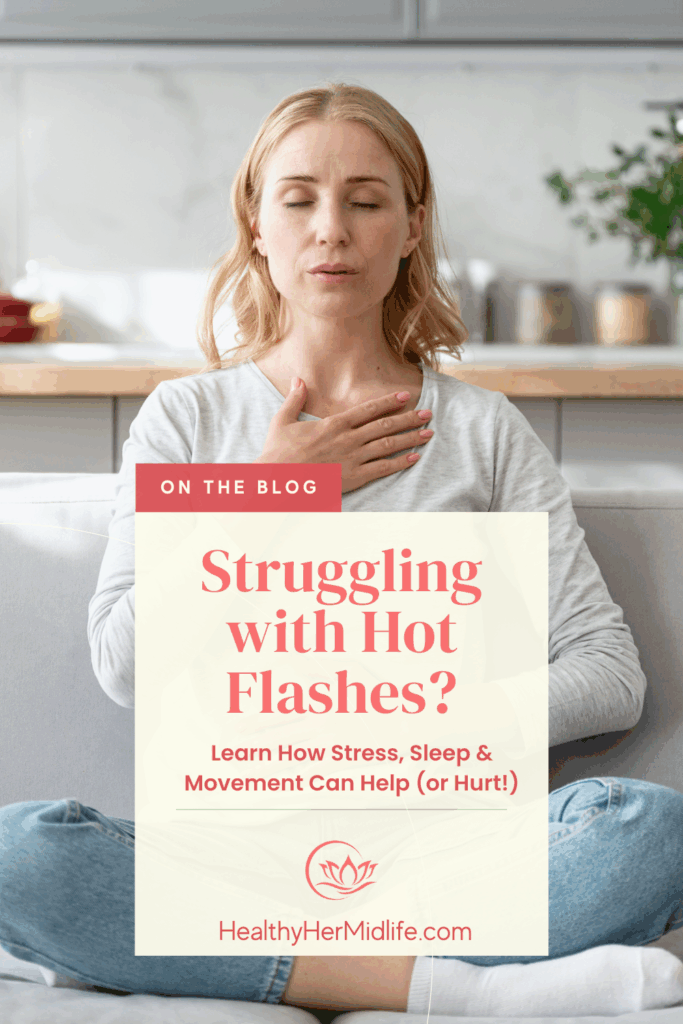Stress, Sleep, Movement & Hot Flashes
Beyond Diet: The Impact of Stress, Sleep & Movement on Hot Flashes (and What to Do About It)
The Stress-Hot Flash Connection
Hormonal chaos isn’t just about estrogen on a roller-coaster ride. Your HPA axis—the brain-adrenal hotline that pumps out cortisol—goes into high gear when you’re juggling deadlines, aging parents, and teenagers learning to drive. Elevated cortisol throws your thermostat (a.k.a. hypothalamus) off, making hot flashes more intense and frequent.
Cool-Down Strategies
| Technique | Why It Works | Quick-Start Tip |
|---|---|---|
| Mindfulness apps (Insight Timer, Calm) |
Lowers cortisol within minutes | Five-minute body scan at lunch |
| Restorative or Hatha yoga | Activates the parasympathetic “rest-and-digest” system | Two poses before bed: Legs-up-the-Wall & Supported Bridge |
| Nature breaks | Green spaces can reduce stress hormones by up to 20 % | Schedule a 15-minute “sunshine meeting” with yourself |
| Journaling | Processes worries and clarifies boundaries | Try the “Three Wins & One Let-Go” nightly prompt |
Pro tip: A polite “I’m at capacity right now” is a hot-flash-prevention technique in disguise.
Optimizing Sleep When Flashes Strike
The cycle is brutal: hot flash → sleep disruption → higher cortisol & lower melatonin → even more hot flashes. Let’s break it.
Sleep Hygiene for the Win
- Consistent lights-out & wake-up: Yes, even on weekends. Your circadian rhythm loves routine.
- Bedroom micro-climate: 60–67 °F (16–19 °C), blackout curtains, and a white-noise app. Try moisture-wicking bamboo sheets or a ChiliSleep cooling pad.
- 30-minute wind-down ritual:
- Epsom-salt bath with a drop of lavender
- Blue-light-blocker glasses + paperback novel
- Five-minute gentle stretch
- Night-time wake-ups: Keep chilled water and a mini fan on the nightstand. Up for 15+ min? Move to dim light elsewhere until sleepy again.
Movement for Menopause
Exercise is medicine—until it’s too much. Intense marathon-style training can spike adrenaline and trigger flashes. Consistent, moderate movement improves insulin sensitivity, boosts mood, supports bone density, and enhances circulation (read: better internal cooling).
Build Your Menopause-Friendly Fitness Mix
- Brisk walking or cycling: Aim for 150 min per week.
- Swimming: Natural coolant + joint friendly = double win.
- Strength training: 2–3 sessions weekly—think dumbbells, resistance bands, or body-weight circuits.
- Yoga & Tai Chi: Combine strength, flexibility, and calm.
- Listen to your body: On flare-up days, swap HIIT for restorative stretching or a leisurely stroll.
How Stress, Sleep, Movement, & Hot Flashes Work in Synergy
When stress drops, sleep deepens. And when you sleep better, you move more. When you move regularly, you handle stress with ninja-level resilience. Layer these rhythms on top of the cooling foods and hydration tips in the video, and you’ll build a holistic fortress against hot flashes.
Your Next Step Toward Relief
Hot flashes aren’t a life sentence—they’re a dashboard warning light. By fine-tuning stress sleep movement hot flashes dynamics, you can dial down the heat and reclaim comfort in your own skin.
Ready to turn these insights into daily habits? Consider coaching to kick-start your nutrition, mindset, and lifestyle rhythms for real relief.
Stay cool, beautiful friend—inside and out.









